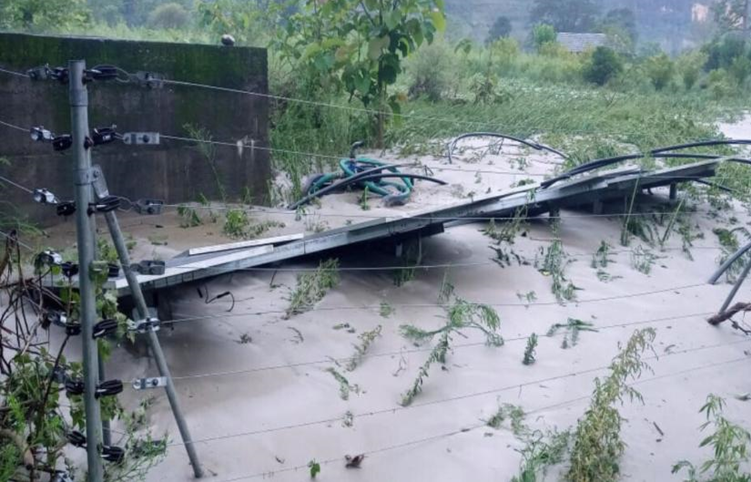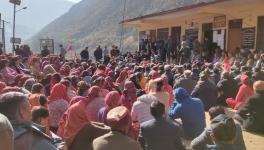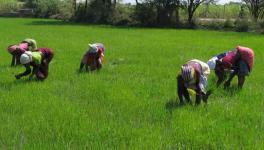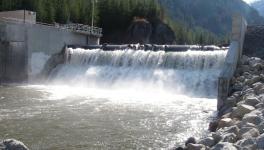Himachal Farmers Struggle With Crop Destruction, Debris

Agricultural fields and solar fencing damaged by the flooded Beas River in Syoh Panchayat, Mandi district.
Mandi: “The flood triggered by rains on July 9 not only destroyed our hardwork for the year but also our land in a way we have never seen before. The deluge brought an overwhelming amount of sand, debris and stones, damaging the crops grown on our 12 bighas. A thick layer of almost one-foot-high debris now covers our once-fertile land,” says Rishabh Saklani, a farmer from Sidhpur panchayat, in Dharampur block of Mandi district, Himachal Pradesh.
This year, incessant rainfall have lashed parts of north India, disrupting normal life and causing devastation. Several roads were blocked and many people were stranded because of landslides. Himachal chief minister Sukhvinder Singh Sukhu has sought about Rs 8,000 crore from the Centre to rebuild the state

Rishabh Saklani, a farmer from Sidhpur panchayat, in Dharampur block of Mandi district, will have to spend Rs 2.5 on excavators to clear the debris to make his land arable again.
Saklani, one of the many farmers dealing with the aftermath of the floods, tells 101Reporters, “My family of 12 depends on the crops for livelihood and sustenance. Usually, the yearly production of food grains and vegetables is, at least, enough for us to survive. But I have lost all my crops due to the rain and suffered a loss of around Rs 1.5 lakh not to mention the money spent on cultivating the crop.”
“To make the land arable again, I must clear this debris. This is not a task that can be managed with human strength alone. We will have to hire machines, and it will cost me an additional Rs 2.5 lakh. I am concerned about how I will get the money,” he adds.
Saklani explains that excavators will be needed to remove the coating of silt, debris and stone, which cost Rs 2,000-2,500 per hour. “It will take around a week to clear the land. We also have to reconstruct the concrete retaining walls and repair the fence around the farm which is put in place to protect the land from stray animals. This is all added expense,” he says. Saklani cultivates maize, paddy, ragi, potato and seasonal vegetables on his land.
According to government estimates, around 9.4 lakh farmers in the state have been affected.
Agricultural expert and farmer Padma Shri Nek Ram Sharma says, “The accumulation of debris in the fields following the river inundation will detrimentally impact the soil’s fertility. The longer farmers wait to remove the debris, the more the nutrient quality of soil will be affected, further increasing the cost of cultivation in the next crop cycle.”
Nisha Kumari, a farmer from Syoh village, in Mandi district —situated on the banks of Beas—shares a similar story. “My four bigha land is filled with debris; there is sand, plastic, wood and construction material. There are places where chunks of the top layer of soil have been washed away due to the powerful current of the floodwater. Whatever is left behind has depleted the soil’s fertility. The land’s productivity will not be the same even after we remove the debris. We have never witnessed floods of this magnitude before,” she says.
Kumari says that she is uncertain how she will recover from the devastating impact of the floods.
Indiscriminate development in sensitive hill districts
According to the India Meteorological Department data, Himachal Pradesh received 249.6mm of average rainfall between July 1 and July 12—almost a 70% hike from the normal average of 76.6mm.
The state has seen unplanned infrastructure development — many new highways have been constructed, old clay houses upgraded to concrete houses, new hotels have come up, and there has also been illegal construction and encroachment of riverbed, which aggravated the flooding in the states, says former Shimla deputy mayor Tikender Singh Panwar, who is also a fellow at Impact and Policy Research Institute.
“Continuous construction on riverbeds over the years is a big concern and exposes the malpractices of governments. The encroachment of riverbeds not only makes the area prone to natural disasters but also increases the intensity of the destruction,” he adds.
“In Kullu, Manali and Mandi, the construction on riverbeds was blocking the natural course of the river and water flow. The floods and flash floods washed away these constructions and hence they landed on the agricultural fields. During flooding, the debris flowed with the water and because of the high density, the waste had the strength to uproot everything that fell along its path … This is a wake-up call. We need to rethink where we are going and what kind of development do we want?” he warns.
Environmentalist Ashwani Sharma expresses apprehension over the disorderly and unscientific construction in the mountains. “During the recent floods, substantial construction material flowed with the floodwaters. This influx of construction material has significantly exacerbated the extent of the damage caused,” he tells 101Reporters.
“It is necessary for the state government to thoroughly reassess and formulate regulations pertaining to construction activities in mountainous regions.”
Rebuilding: Surveys and compensation
According to data compiled by the Himachal Pradesh Agriculture Department, at least, 1,571 hectares of arable land in Mandi district have been affected due to the floods.
Expanding the perspective to the entire state, the downpour in Himachal Pradesh has caused damage to an extensive area of 1,30,518 hectares. When accounting for the additional impact on crops, the agricultural sector of the state has incurred a loss of Rs 167 crore during the monsoon season.
State agriculture secretary Rakesh Kanwar says, “Officials are on the ground to compile a comprehensive report. Affected farmers will receive compensation in accordance with the government’s established regulations.” The State Disaster Management Authority has completed a preliminary assessment.
The state government has increased the compensation for farmers. Earlier, farmers were provided Rs 1,400 per bigha for losses incurred due to silting, which has been increased to Rs 5,000 per bigha. The compensation for crop loss has gone up from Rs 300-Rs 500 per bigha to Rs 2,000 per bigha. The compensation on land washed away due to flood has been increased from Rs 3,600 to Rs 10,000.
According to a state government notification, compensation will be provided by the State Disaster Response Fund.
“We are appealing to the government to compensate the affected farmers soon,” deputy sarpanch of Sidhpur panchayat Lekhraj Palsara says. According to Palsara, around 40 farming families have been affected in his panchayat.
“The agriculture department is estimating of loss along with the local village revenue officer. Compensation will be disbursed based on the assessment report filed by officials. The whole process may take up to six months,” he adds.
However, according to Sanyukt Kisan Morcha co-convener Sanjay Chauhan, this substantial increase will not benefit the farmers.
“The enhanced compensation will offer little help to farmers whose lands have been completely lost—not to mention that usually the compensation amount is released very late. Farmers should be compensated within a fixed timeframe considering the next cropping season,” he says.
“In addition, the government has to devise ways to ensure that this does not happen again. The government should ban illegal construction and take serious action against the offenders.”
The writer is a Himachal Pradesh-based freelance journalist and a member of 101Reporters, a pan-India network of grassroots reporters.
Get the latest reports & analysis with people's perspective on Protests, movements & deep analytical videos, discussions of the current affairs in your Telegram app. Subscribe to NewsClick's Telegram channel & get Real-Time updates on stories, as they get published on our website.
























